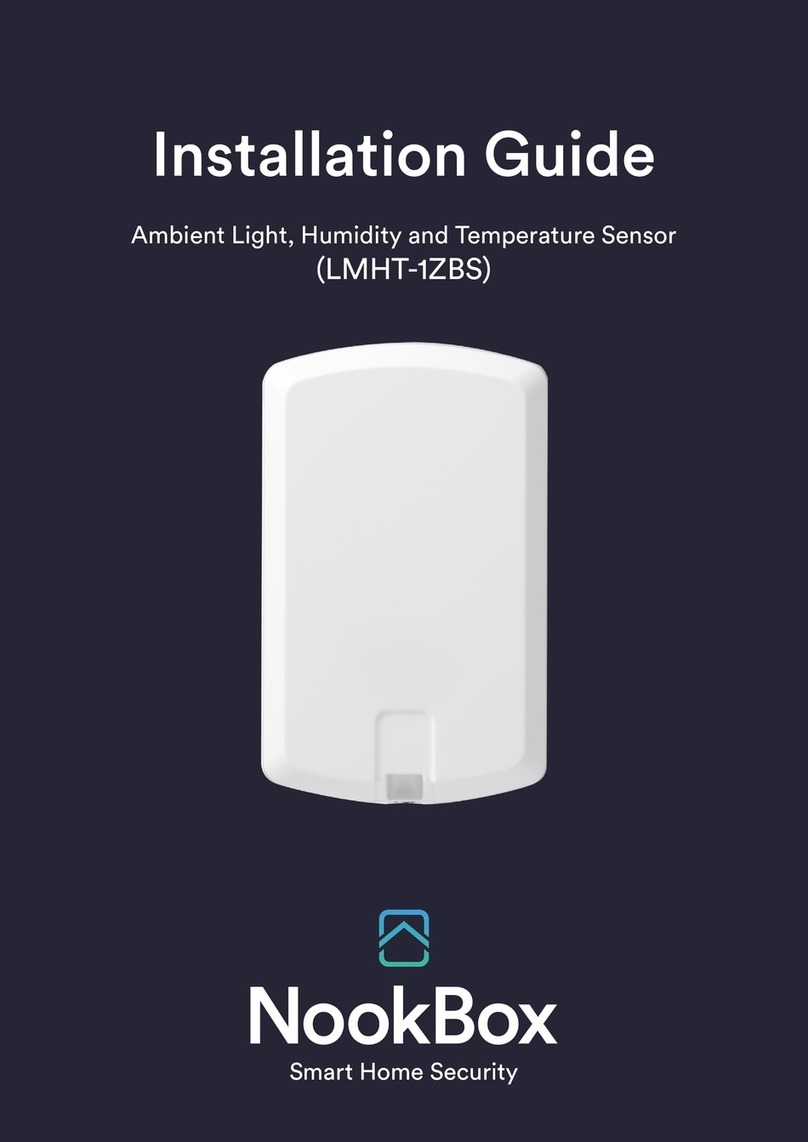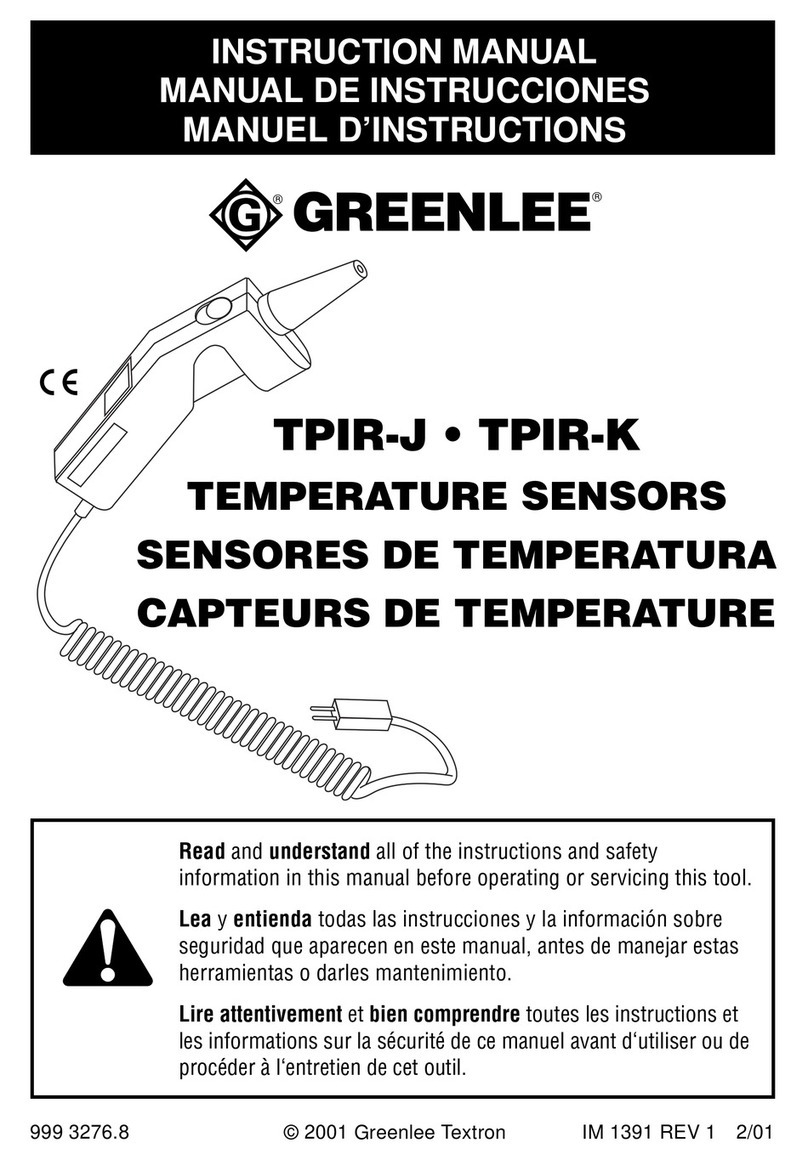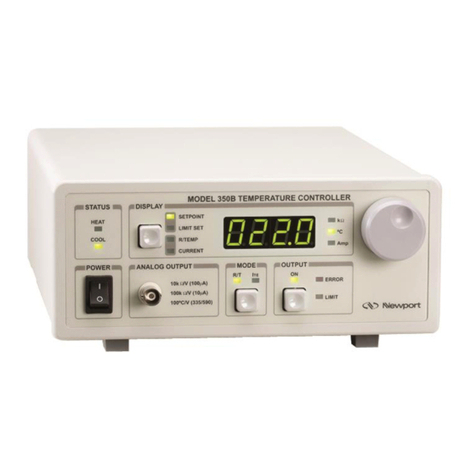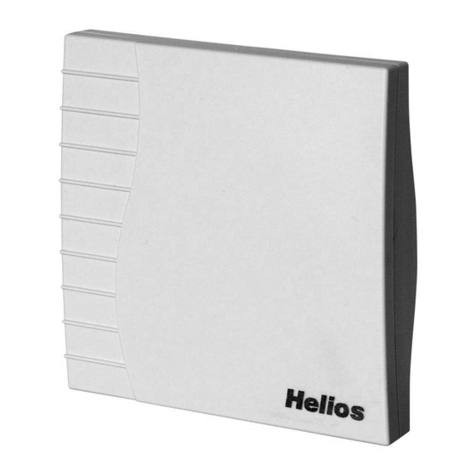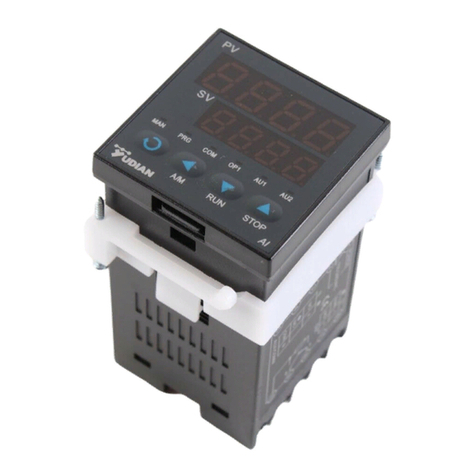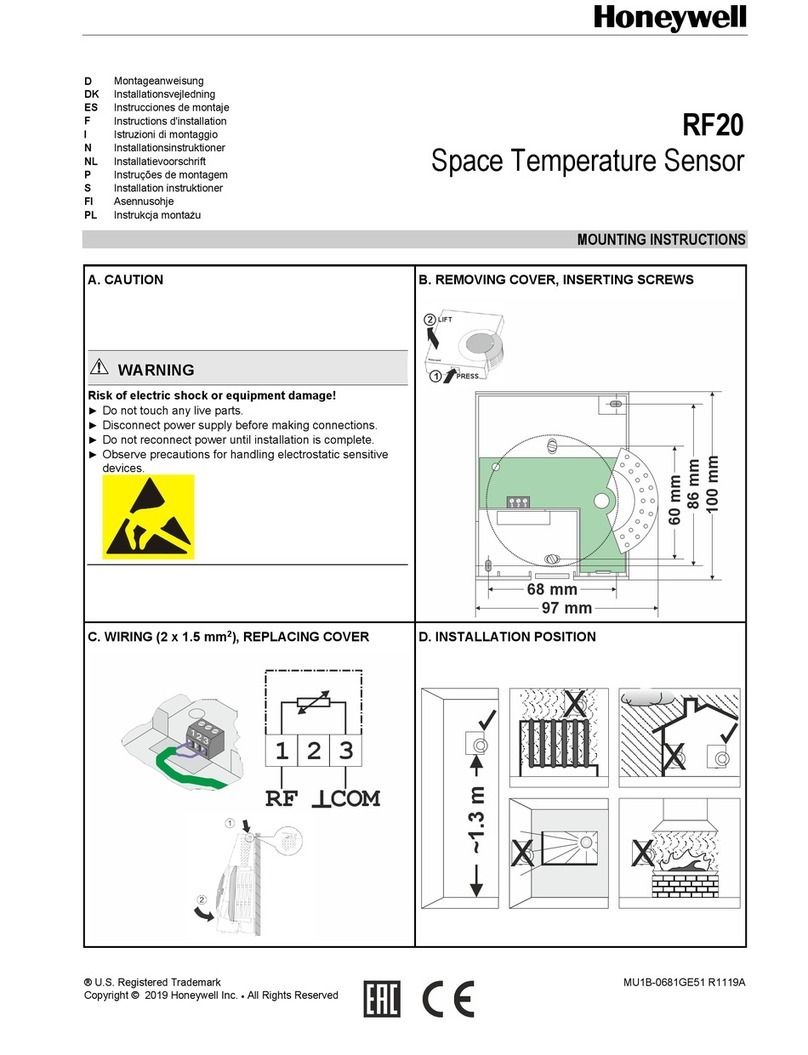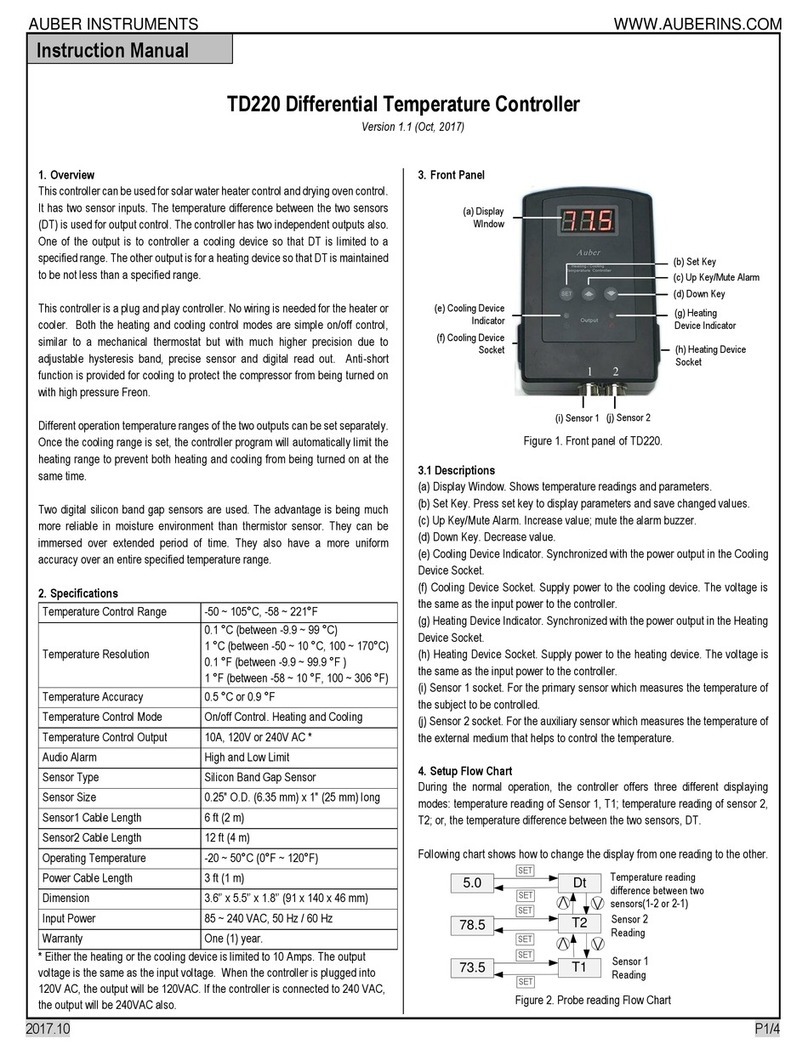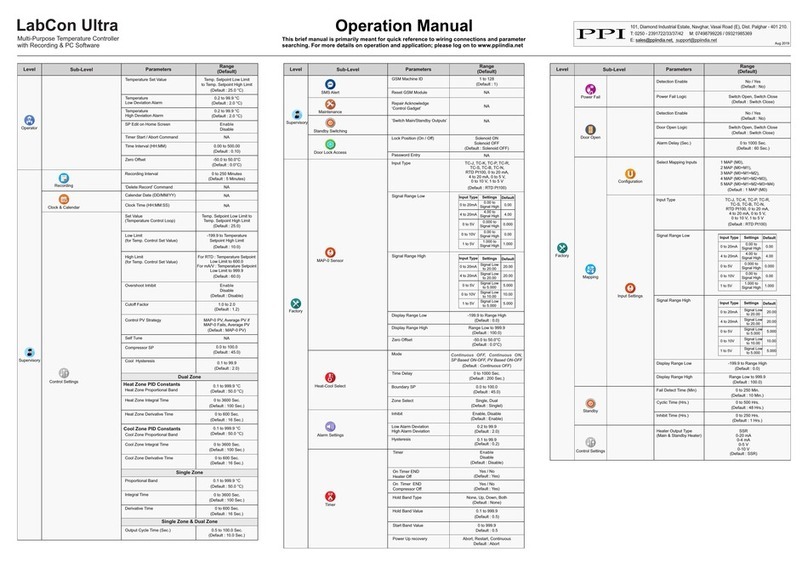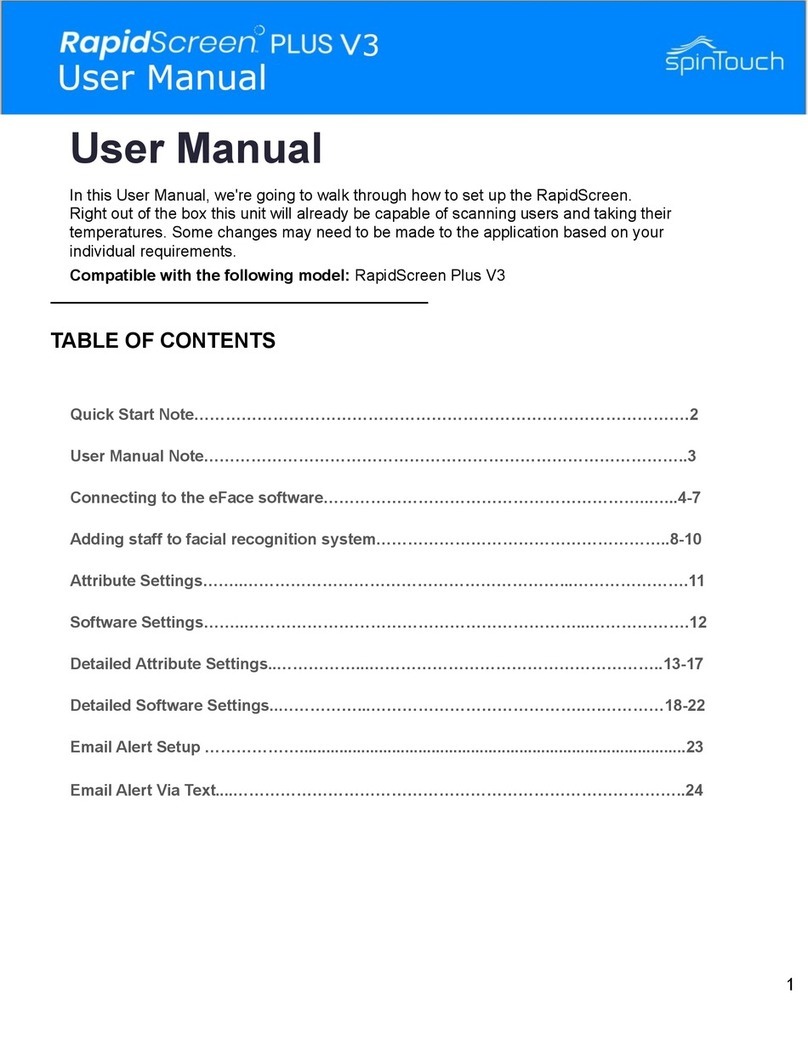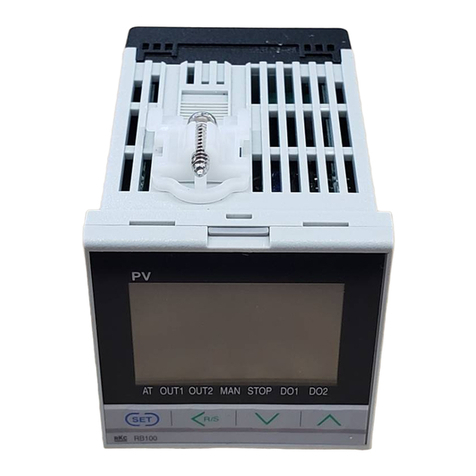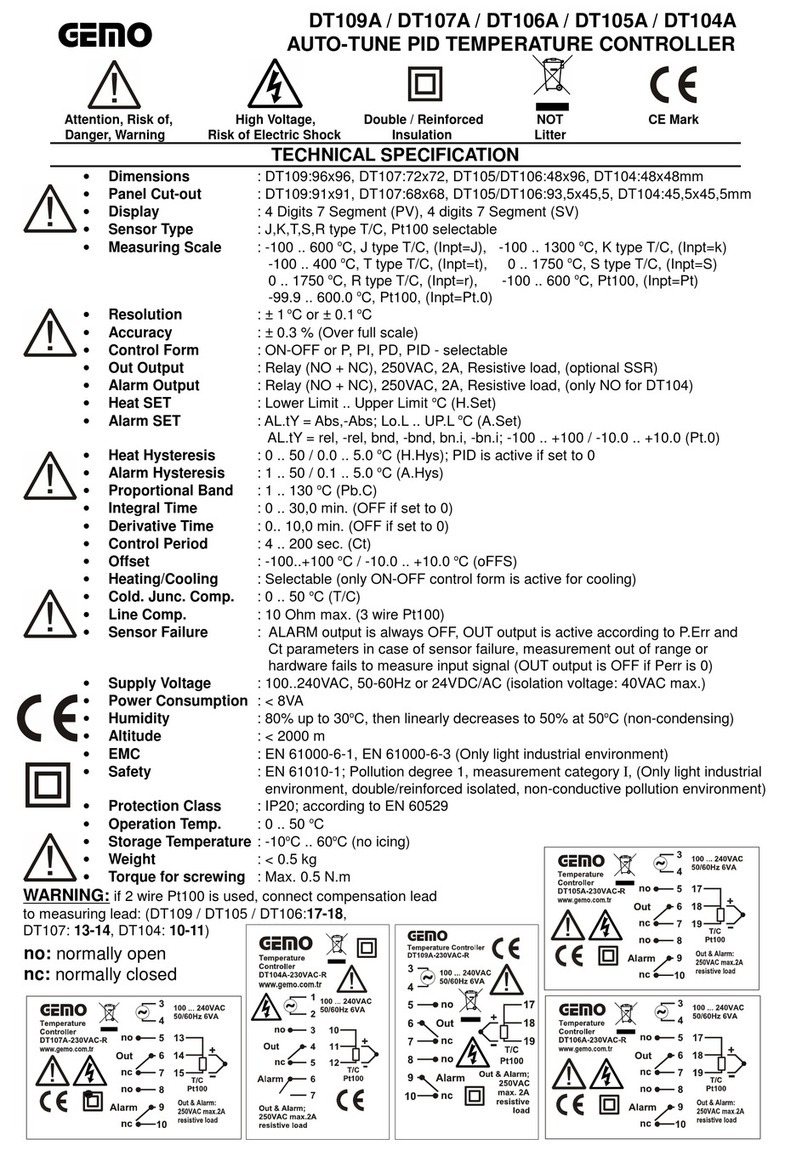Thermo Technologies USDT 2004B User manual

USDT 2004
Installation and User’s Guide
Introduction
General Information 2
Installation
Collector Sensor 3
Control Box 5
Operation
Power Connection 6
Operating Display 6
Changing Factory Settings 8
Manual Operation Of Pump 9
Advance Operation 10
Frost and Overheating Protections 12
Energy Calculations 14
Troubleshooting 15
Thermo Technologies
9009 Mendenhall Place • Suite E
Columbia, Maryland 21045
Phone 410.997.0778 • Fax 410.997.0779
e-Mail i[email protected]
Revision 4.0, October 2007

2
Introduction
Note: The information supplied in this manual is for guidance only -no part of this may be used
for any agreement, whether express or implied, or to form any contract. Thermo Technologies
reserves the right to change specifications without prior notice.
SDT 2004 is a powerful temperature differential control unit and may be used in a wide
range of applications. The user has the choice of *two modes:
Par Mode (access code 32) –This program is USDT 2004's basic program. It uses two sensors
to control a simple solar water heating system and factory settings may be altered.
Men Mode (access code 64) -This program, initiated by the user, customizes USDT 2004 for
applications involving a BTU Meter or where a third sensor (or reference value) is required.
*NOTE: USDT 2004 may be used for several advanced applications originating inMen Mode.
USDT 2004 has the following functions:
•2 inputs for temperature sensors
•Input for flow rate input or additional temperature sensor
•BTU meter capability for constant flow rate or with a puls flow meter
•Adjustable (-4o F to 39 o F) frost protection
•Adjustable (32 o F to 299 o F) overheating protection
•Adjustable (1o F to 99 o F) temperature difference ?T
•Manual pump operation
•Digital display of all parameters
•System status and diagnostic displays
Two -Sensor Operation
At its most basic function, USDT 2004 is a two-sensor
solar hot water controller. One sensor (S1 in diagram)
monitors the collector temperature whilst the other sensor
(S2) monitors the temperature at the bottom of the
storage tank. The solar loop circulation pump runs while
the collector temperature exceeds the tank temperature
by an adjustable temperature difference diff. To avoid
overheating, the circulation pump stops if the tank
temperature (T2) reaches the adjustable high limit (TMAX)
temperature. The pump A1 runs only when the
temperature at the collector sensor location S1 is higher
than the tank temperature at location S2 by at least diff
(?T). The pump stops if diff is less than the preset value
or, when the temperature at location S2 has reached the
TMAX :A1 (ON) only when S1 > (S2 + diff) & S2 < T max
The temperature hysteresis (a lagging in the set-point) may over-ride diff to avoid pump cycling.
U
S1
S2
A1

3
INSTALLATION
Note: This installation procedure is for guidance only, and the installer should verify its
suitability. Make sure that the solar system is physically installed, manually tested, and ready for
controlled operation.
he following safety precautions are strongly recommended:
1. Before attempting to install and operate the unit read this instruction manual carefully.
2. Only suitably qualified personnel should carry out installation and required maintenance.
3. It is recommended that the unit be connected to the power supply via an on/off switch or plug.
4. WARNING: When the unit is connected to the 115-volt power supply and the cover is
opened, high voltage circuits will be exposed. When installing the unit, all required
connections should be completed and the cover attached to the controller box before turning
the power on. Ensure that all connections are secure. If any maintenance work is required
isolate the unit from the power supply before removing the cover. Never leave the unit
unattended if the cover has been removed and the power supply is connected.
5. Do not exceed unit ratings of 3.15 amps (1/6 HP or 245 Watts pump).
6. It is advisable to route power cables away from sensor cables.
ensor installation: Temperature sensors may be installed in fluid lines by mounting in a
well or strapping directly to piping. For the system to function correctly, it is essential that
the sensors are located and installed properly. Sensors must be well insulated in order to
prevent influence by the ambient temperature.
When used outdoors, water must not enter the immersion sleeves. Exposure to moisture (e.g.
condensation) can diffuse through the cast resin and damage the sensor.
Corrosion-resistant immersion sleeve (sensor pockets) must be used when sensors are used in
open loops or swimming pools.
l Collector sensor (red cable with protective terminal box): Push into a thermowell, (sensor
pocket), which is soldered or riveted directly to the manifold (vacuum tubes). Alternately, strap
the sensor to the collector outlet pipe or the absorber (flat plate collectors) that projects from the
collector housing. Ideally, house the collector sensor (encased in a suitable sensor pocket) into a
T-piece on the collector return outlet. Protect the sensor cable from UV and moisture.
T
S

4
l Tank sensor (white cable): This sensor, required for the solar loop return, is installed in the
lower part of the storage tank. If there is no provision for this tank sensor, push the sensor
beneath the insulation –keeping it close to the inner tank wall at the desired tank location.
For external heat exchangers, the tank sensor should be installed with an immersion sleeve in the
return leg (cold side) of the heat exchanger. In tanks with integrated heat exchangers, the sensor
pocket should be fitted at the exchanger's return to the collector.
l Pool sensor installation: Place a heat conductive T-piece on the suction line directly at the
pool outlet and screw in the sensor with an immersion sleeve (check corrosion resistance of the
material used). Alternately, attach the sensor with clips or adhesive tape, using the appropriate
thermal insulation to guard against environmental influences.
l Sensor cable extension: Sensor cables (22/4 AWG telephone cable; only two wires of 4)
can be extended up to 150 ft. A connection between the sensor and extension can be established
as follows:
Cut the supplied heat-shrinkable tubing to desired length (about ½ ”). Slide tubing over one end of
wire to be sliced (after removing enough outer insulation to accept the tubing). Splice the wire
and slide tubing over the splice. Heat gently all around until tubing shrinks tight.
Slide larger tubing (about ¾ “) over the entire splice. Heat gently all around until tubing shrinks
tight. This connection can then be drawn gently into the pipe work. Only two of the wires are
required for the sensor cable; the other two wires are kept spare.
Caution:Do not overheat the tubing! Remove heat as soon as the tubing shrinks tight, as
material will continue to shrink. With a heat gun or flame source, use an even back and forth
motion all around tubing. Let tubing cool for maximum strength.
ontroller unit installation: For viewing comfort, the controller unit should be positioned at
eye level. For optimum longevity, avoid extremes of temperature in the placement of
electronic equipment. In addition, avoid heavy electrical loads, switches or contactors as these
may cause electrical and electromagnetic interference with the unit (when switched on or off).
C

5
Undo the screw at the top of the housing. The control electronics are mounted on the enclosure
cover. The controller enclosure can be screwed to the wall with cable entry grommets pointed
downwards. Use the supplied plastic bridges to secure power and sensor cables.
Base of the unit to be mounted at eye-level and wired as shown above
Caution: Controller wiring should only be done when the unit is not energized. It is possible to
damage the control unit if it is assembled under voltage. Miniaturized terminal blocks are used for
making wiring connections. The wire is held in place within the terminal with screw that provides
excellent contact without damage to the wire.
Sensor Cable Connection: Use up to an 18 or 22 AWG stranded wire to connect the sensor
cables to the unit. The S1 terminal should be connected to the collector sensor (higher
temperature); the S2 terminal is designated for the tank sensor (lower temperature). And the S3
terminal is reserved for the advanced usage of the unit such as a third temperature sensor or flow
meter input for BTU operation.

6
ower Connections: A small blade screwdriver may be used to fasten miniaturized
terminal block screws while the corresponding wire is inserted.
NOTE 1: Always disconnect the controller from the power supply before opening the
housing.
NOTE 2: The controller should be properly grounded. Flexible wires, 18/3 AWG
(gauge/conductor) simplify connection to the terminals. The power terminal block will
accommodate wire sizes up to 14 AWG. All connections should be secured and adequately
tightened, as loose power connections will over-heat, and may cause fire.
NOTE 3: It is important that the specified output loads (245 Watts) are not exceeded. Where
these loads expect to exceed, external relays must be used. It is good practice to install a switch
to disconnect the controller and pump from power. Always keep power cables away from sensor
cables and other low voltage signal cables.
NOTE 4: To protect against lightning damage, the system must be grounded according local
regulation. Sensor failures due to the weather or electrostatic are mostly due to poor grounding.
OPERATION OF
DIGITAL DISPLAY
our controller displays information one request at a time. The unit display window has
three lines to inform you about the system's status, unit of displayed parameter and
its value.
Upper Line Display Symbolic display of sensor location, reading unit, and operation domain
Center Line Display Sensor ID and its reading in normal mode (user interface window)
Lower Line Display Set-point indicator that illuminates only during programming mode
ðPush selection key once to move to the next selection; or increase the selected
parameter by one unit while display is blinking.
ïPush selection key once to move to the previous selection; or decrease the selected
parameter by one unit while display is blinking.
P
Y
Y

7
òPush selection key once to enter the advanced (Par or *Men) mode. Once in selected
mode, press one more time to select the parameter in that mode. Selected parameter
blinks allowing the user to modify it. You can modify the selected parameter while the
middle window blinks by pressing the ïor ðkey.
ñPush selection key once to accept selection (blinking stops showing the new set-point
steady) or go back to the previous selection.
*Men mode is for use with advanced applications.
Use selection keys ïð during normal system operation to display the desired parameter:
T1 xxx Collector temperature in oF
T2 xxx Tank temperature in oF
T3 xxx Reading of the third sensor; if the third sensor displays a fixed reference
temperature of 999 oF, the sensor designation can be wrong or the sensor is not
connected correctly (open circuit).
G xx Flow rate [gallon/h] –programmable by user
XX xxx Collector power in [kW] –amount of energy collector is producing
YY xxx Energy collected in [MWh]
ZZ xxx Energy collected in [kWh]
STAT Display of the system’s status. Any current problems outlined.
Example: The following windows display the temperatures of T1 (the collector), T2 (the
bottom of the tank) and T3 (3rd sensor see P.11)
At the upper text line, the icon for the text is always displayed. Program symbol is displayed
during the setting of parameters at the lower text line
Basic Mode (Par): Pressing the selection key ðseveral times allows you to navigate sensor
temperatures and energy output and also access (Par)mode. Push selection key òonce to enter
the program mode.
Advanced Operations: Pressing the selection key ðseveral times allows you to enter into the
advanced mode (Men). Push selection key òonce to enter the program mode.

8
CHANGING FACTORY SETTINGS:
Temperature differentials and manual operation of pump
Par Mode is USDT 2004's basic program; it uses two sensors to control a simple solar
water heating system. The unit is already factory set with ON/OFF pump temperatures.
However, these temperatures may be altered if required:
Par Using the navigation key ^_ allows you to select the desired parameter while you are in
the program mode. Press the selection key òonce to select the parameter in the window.
Selected parameter blinks allowing you to modify it. You can modify the selected parameter while
the middle window blinks by pressing the ïor ðkey. The unit accepts the new value by pressing
the ñkey once. Please make sure that you are in Par mode.
RUV 3.5 –Displays the software revision number corresponding to this manual.
PR O –Inapplicable
PROGRAMMING THE TEMPERATURE RANGE
USDT 2004 is factory set at approx T2 > 161 oFPUMP OFF, T2 < 150 oFPUMP ON. Once Par
mode has been accessed, using Code 32 as illustrated above, the user may program a different
temperature range. There are two temperatures that should be entered:

9
Tank Overheating Protection
In Par Mode, user can customize the temperature range by using max?and max=.Use the
navigation key ^_ in Par to locate max temperatures and push selection key òonce to make
changes:
max?1Pump stops above tank temperature (T2)
max=1Pump runs again below this set point (T2)
Temperature Differential Adjustment
diff=1Pump runs when temperature difference between collector T1 (collector) and T2
(tank) exceeds this value. Factory setting is 15.1 oF. Consult your collector
manufacturer for the recommended value.
diff?1Pump stops when temperature difference between collector T1 (collector) and T2
(tank) reaches this value. Factory setting is 7.0 oF. Consult your collector
manufacturer for the recommended value.
Manual Operation of Pump
The pump can be manually turned on or off once Par mode has been accessed using Code 32:
AUTO Use the navigation key ^_ in Par to locate the pump window O AUTO.Push
selection key òonce to enter pump operation (ON or OFF). When the manual mode
has been selected, an icon (a small icon symbolizing a right hand image) appears
under the text line.
Automatic mode
Manual ON
Manual OFF

10
ADVANCED OPERATIONS
or 3rd sensor designation
Men Mode customizes USDT 2004 for applications in conjunction with a BTU meter, a third
sensor or reference value. If BTU capability is not required, this program may also, for
example, measure the flow rate or the temperature of the storage tank (T3, top of the tank).
Men Use the navigation key ^_ to navigate to the Men Window. Use Code 64 to access and
program Men mode.
Navigation of advanced features of the unit and selection of parameters is the same as before by
using ïòñðkeys:
Advancing –Press the Advance key ïð briefly to advance to the next selection or to
increase/decrease the set point of the selected parameter. Hold it down for fast change.
Acceptance –Press Set-Up key òonce to select the parameter. Press ñkey to accept the
selection or the set point.
ENGL –Pre-Set to English. Spanish available in INTER.
CODES –64 for Men Mode.
SENSOR : USDT 2004 accepts two different sensor types or a reference value. Press the
Advance key ïð briefly until SENSOR appears in centerline and press the key ò. Ensure the
reference value readsKTY sensor, all factory supplied sensors are KTY type:
SDT 2004 is extremely powerful. All factory settings can be changed to meet the
unique requirements of other applications. All advanced operations have their origin in
Men Mode where USDT 2004’s parameters may be altered depending on the
application.
U

11
The factory setting will be retrieved by pressing and holding òkey during powering of the unit. A
“WELOAD” displays for three seconds while factory settings are restored.
Mode Operation
SENSOR Selects sensor type
SGUARD Protects system from overheating and frost
START Starts pump at pre-set insolation (solar radiation intensity)
ATAfter-running time. Factory-set at 0.
ALARM Enables/Disables protection functions
BTU Energy calculation and setting
ensor Designation –USDT 2004 accepts two different sensor types or a reference
value . User can program a constant reference temperature instead of a sensor output.
The factory-preset sensor is the thermistor (KTY 10) type. The KTY 10 tank sensor,
white wire, should be used in a conditioned environment and will not be permanently damaged up
to 360 oF.
Selection:
S1 Sensor 1 (collector outlet) selection
S2 Sensor 2 (collector inlet) selection
S3 Sensor 3 (tank) selection
Designation:
PT PT 1000 sensor (1000 Oat 0 oC, not available in US market)
KTY Thermistor sensor (2000 Oat 25 oC)
GBS Radiant sensor (not available in US market)
(- Fixed value, the unit uses this value instead of measured temperature
S3(-S1 Transfer of values (not used in program 0 operation)
DIG Digital input (not used in program 0 operation)
OFF The sensor reading is not displayed
VSG Flow rate reading
Sensor wires can receive electromagnetic pulses, which can result in a wrong temperature
reading. The USDT 2004 reads sensor values every 50 ms. It can bundle several readings and
process their average.
AV 1 Sensor 1 average
AV 2 Sensor 2 average
AV 3 Sensor 3 average
The numbers of samples can be programmed from 4 to 20.
S

12
rost and overheating protections -Pump operation can be manipulated by the user in
both collector stagnation and frost conditions. This set-up is possible in System Guard,
SGUARD, Men domain.
Overheating protection (CET) –The Circulation pump may not be powerful enough to circulate
the heat transfer fluid in the solar loop with air pockets. User can program the pump to stop at a
desired maximum collector temperature, shown by ?symbol, to protect the pump. USDT 2004
will take over the normal operation after the temperature decreases to an acceptable working
temperature, shown as =. This feature (ON) can be disabled by user to (OFF). Factory setting
is 260 oF to stop the pump. The pump starts again at 230 oF. Customer in field can change these
settings.
Frost Protection –Frost protection in the sun-belt region is provided by circulating water in the
solar loop when freezing conditions exist. Regardless of the temperature difference ?T, the
circulation pump runs when the collector temperature is below a programmable minimum
temperature, shown by =symbol. The pump stops as soon as the temperature in the solar loop
reaches a safe region programmed by the ?symbol. This feature is disabled at the factory and
displayed as (OFF).
min=Pump runs below this temperature (factory setting 35 F)
min?Pump stops above this temperature (factory setting 39 F)
tart functions -The Circulation pump can be programmed to start on a low insolation
level. The Start function feature is useful when heat transferred to the collector sensor is
not fast enough for an early start; especially when the collectors are flat mounted.
The enabled start function runs the pump at a given solar radiation or programmed temperature
difference. The feature is disabled at the factory.
START Start function screen
ON Enable start function
OFF Disable start function
If this feature is selected, following parameters must be adjusted for proper operation:
GBS Pyranometer port designation (radiation monitoring sensor port)
1 Sensor 1
2Sensor 2
3 Sensor 3
-- Manual input in next step
INS Radiation threshold in W/m2
CIRC Pump runtime in seconds
INT Maximum interval time in second
FLU Number of flushes
The following example activates the circulation pump at 200 W/m2and runs it for 15 seconds. If
rT condition is met within the time period, the pump stays on.
INS 20 CIRC 15
F
S

13
After-running time AT –During the start phase, the pump may repeatedly switch on and off for a
long time, especially systems with long solar loop. The after-run time AT can be changed from 0
(factory setting) to 9 minutes.
larm functions -User can enable the alarm function of the USDT 2004 in the ALARM
screen. Status of sensors and circulation pump can be viewed if alarm function is active.
A ON Alarm function enable
A OFF Alarm function disable
The status of the system can be monitored in the Stat Mode only if the corresponding feature is
active. The following example shows a system condition with a circulation problem:
CET OFF Collector excess temp. cut-off active (no error occurred)
CET ON No overheating
1 SHORT Short circuit in sensor 1 wiring
2 SHORT Short circuit in sensor 2 wiring
1 OPEN Disconnection in sensor 1 wiring
2 OPEN Disconnection in sensor 2 wiring
OK System operates normal
NO CIRC rT is more than 108 oF in last 30 minutes
OK CIRC Pump is running
CLEAR Clears NO CIRC display after correction
A

14
nergy calculation -Energy gain is calculated by obtaining the temperature increase of
the heat transfer fluid as it crosses the solar collector. The amount of fluid flow through
the collector is registered by an in-line flow meter. USDT 2004 computes the energy production
as a function of the temperature differential and fluid volume. In addition, the system anti-freeze
(Glycol) percentage should be entered as it affects the thermal conductivity and heat transfer
rate.
BTU Energy calculation mode
S IN Sensor port selection for inlet temperature (1, 2, 3, --)
S OUT outlet temperature (1, 2, 3, --)
F SEN Sensor port selection for flow rate (1, 2, 3, --)
Energy calculation will be initiated only after temperature sensor ports are designated. Flow rate
can be either a constant number to be entered by user, or from a flow meter input. To activate the
energy calculation without using the flow meter's impulse input, a dash (-) must be selected for F
SEN channel followed by the constant flow rate in gph (gallon per hour) unit:
GAL Constant flow rate in gph instead of flow meter reading in (--) sensor mode
Select 3 for F SEN when a flow meter is used:
LPP Flow meter rate impulse number in liter per pulse, if flow meter is used
GLYCOL Anti-freeze percentage
DIF (- Sensor calibration
The output of USDT 2004 unit is kW for system power and kWh or MWh for collected energy. The
energy calculation dependents on flow meter accuracy, the temperature sensors class, and their
locations. The flow meter is a mechanical device and its accuracy fluctuates over time. Therefore,
the user should calibrate the flow meter and incorporate temperature sensor tolerance.
The supplied Thermistor sensor has an accuracy of ±2 oF. DIF represents the temperature
difference between two sensors. User can increase the accuracy of reading by adjusting the DIF
parameter. To calibrate the system, insert both S IN and S OUT in the same temperature (such
as ice-water glass), DIF should show “DIF 0” for exact temperature reading. If it is not zero,
accept the difference for better accuracy. This difference will be used as a correction value for
energy calculation. The energy calculation becomes more accurate at temperature range that this
reading adjustment is made.
BTU CL Sets the BTU meter's counter to zero
CLEAR BTU meter's counter is zero
E

15
Troubleshooting
In general, if there is a malfunction all of the settings in the menus Par and Men and the terminal
should first be checked first.
Malfunction, but "realistic" temperature values:
•Check program number.
•Check the switch-on and switch-off thresholds and the set differential temperatures. Have
the thermostat and differential thresholds already been reached?
•Were the settings in the submenus (Men) changed?
•Can the pump (output) be switched on and off in manual mode? If a forced pump “ON”
and “OFF” lead to the appropriate reaction at the output, the unit is certainly in order.
•Are all of the sensors connected with the right terminals? Heat up the sensor using a
cigarette lighter and watch the display.
•Did you change the reference temperature 250 (three sensor operation) to KTY?
Incorrect display of temperature(s):
•Displayed values such as -999 if a sensor short-circuits
•or 999 if there is an interruption do not necessarily mean a material or terminal error.
•Are the right sensor types (KTY or PT1000) selected in the menu Men under SENSOR?
The factory settings set all inputs to KTY.
The sensor can also be checked without a measuring instrument by connecting the presumed
defective sensor to a terminal that works and checking the display. The resistance measured by
an ohmmeter should have the following value depending on the temperature:
T
0
10
20
25
30
40
50
60
70
80
90
100°C
R(KTY)
1630
1772
1922
2000
2080
2245
2417
2597
2785
2980
3182
3392 Ω
The settings of the parameters and menu functions ex works can be restored any time by
pressing the down arrow (enter) while powering the controller. The sign that appears for three
seconds on the display is RESTOR for load factory settings.
If the system is not in operation while connected to the power supply, the 3.15A quick-blowing
fuse that protects the control system and the output should be checked and exchanged if
necessary.
As the programs are constantly being improved, there may be a difference in the sensor, pumps,
and program descriptions. Only the enclosed manual (identical serial number) applies for the
equipment supplied. The program version for the manual must correspond to the equipment
version.
If the control system is found to be malfunctioning despite the checks described above, please
contact your retailer or Thermo Technologies directly. The cause of the error can only be
determined if the settings of the unit is known. The schematic diagram of the system in question
is a great help to isolate the potential problem.
This manual suits for next models
1
Table of contents
Other Thermo Technologies Temperature Controllers manuals
Popular Temperature Controllers manuals by other brands
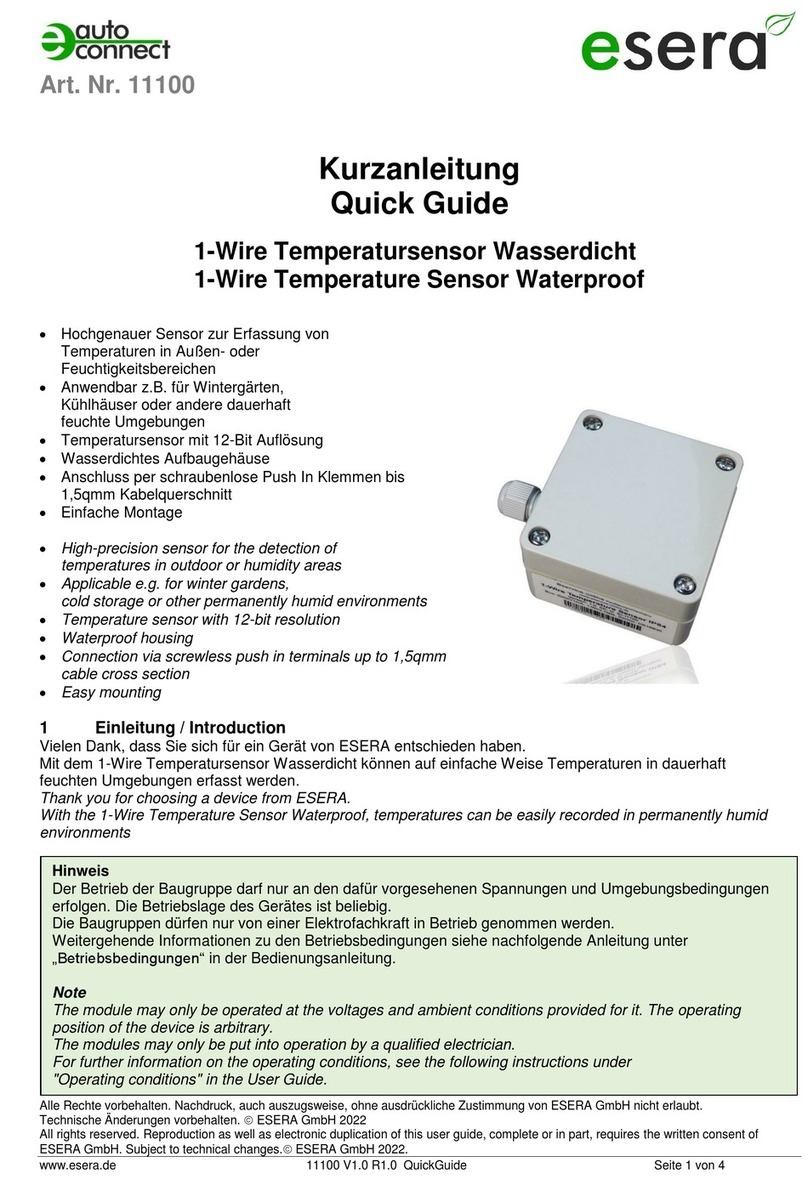
esera
esera 11100 quick guide
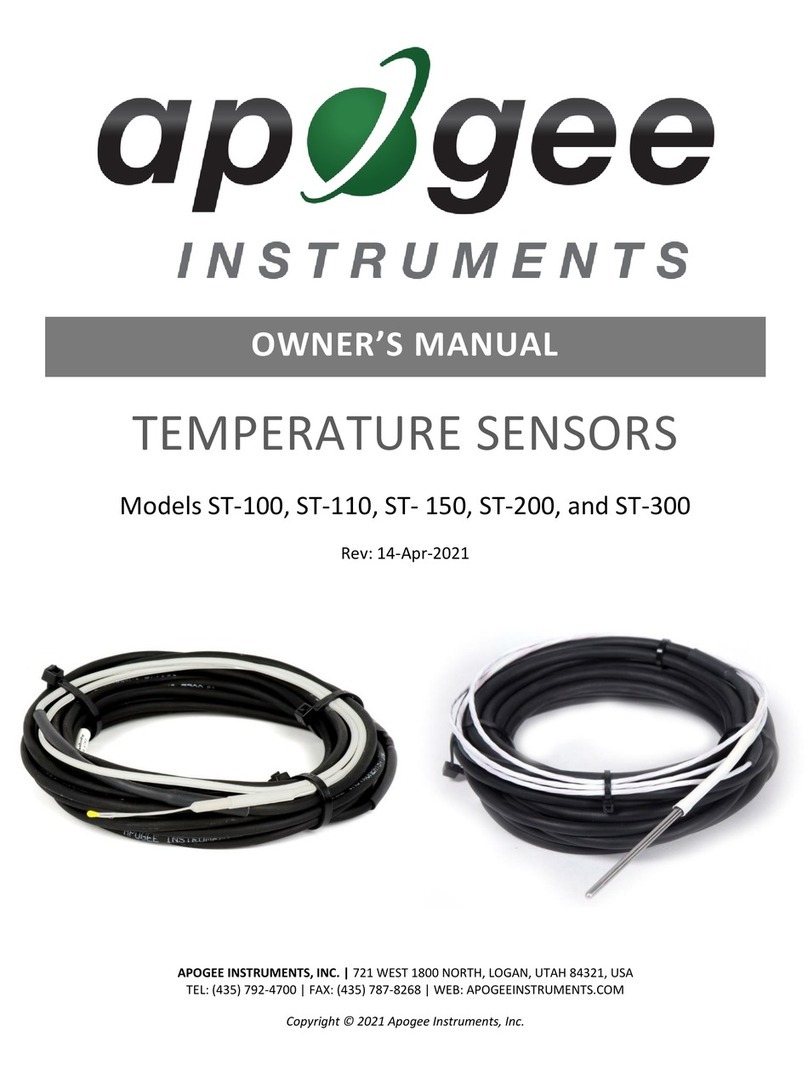
Apogee Instruments
Apogee Instruments ST-100 owner's manual
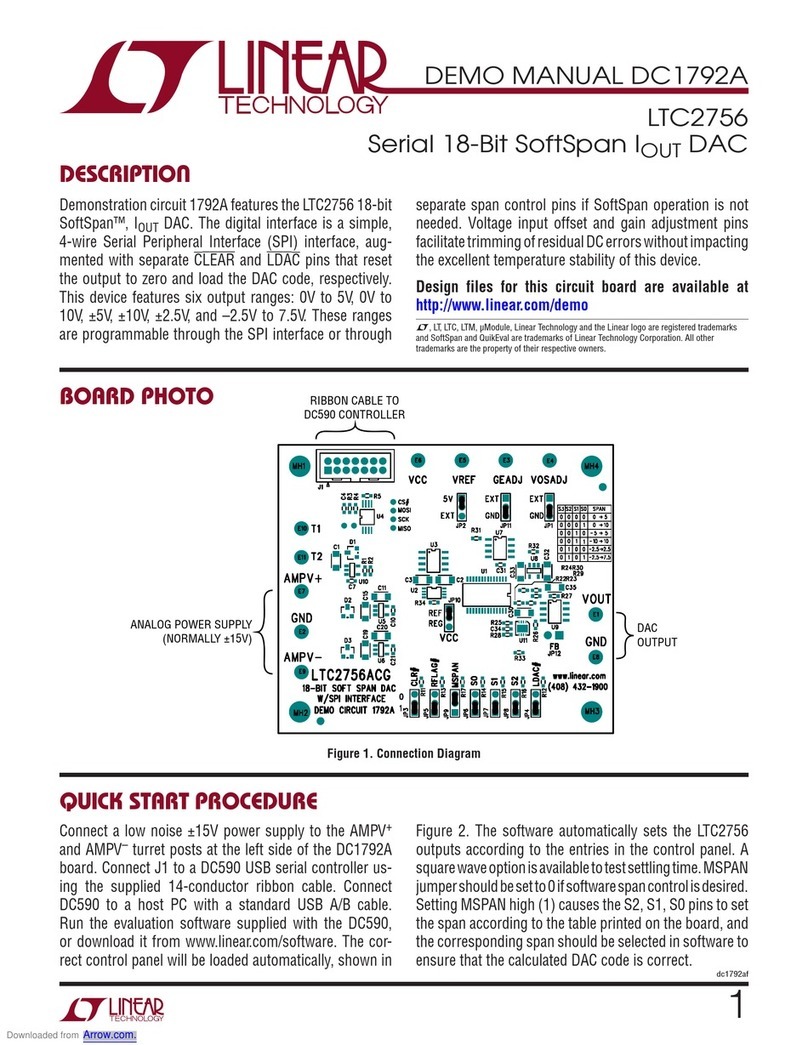
Linear Technology
Linear Technology DC1792A manual
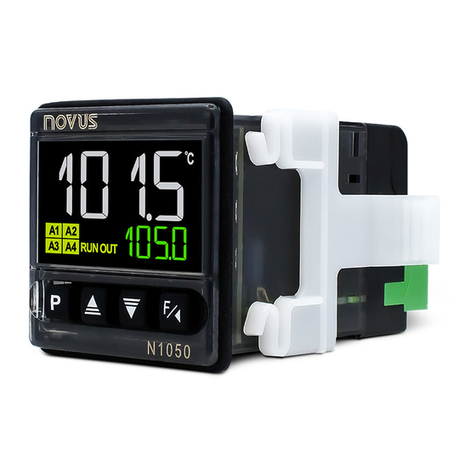
Novus
Novus N1050 instruction manual
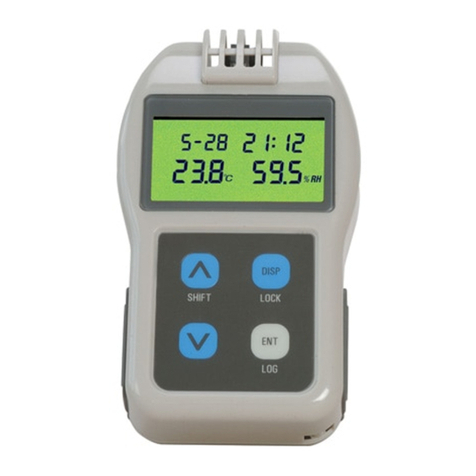
Omega
Omega RH32 Series Basic instructions
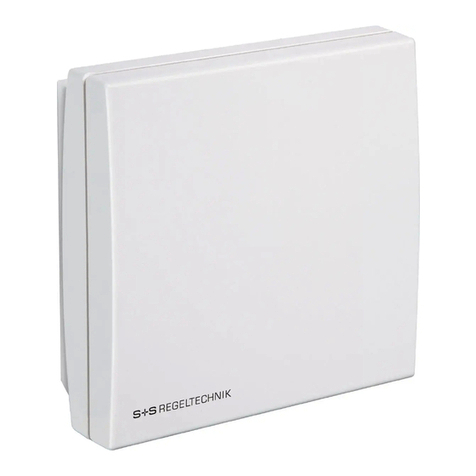
S+S Regeltechnik
S+S Regeltechnik HYGRASGARD RFF Operating Instructions, Mounting & Installation

